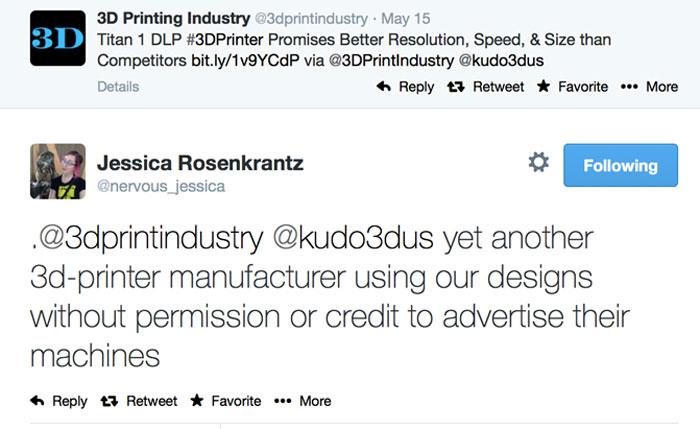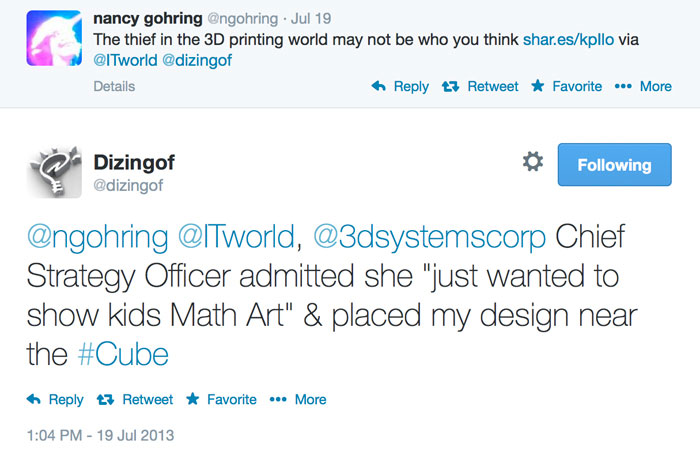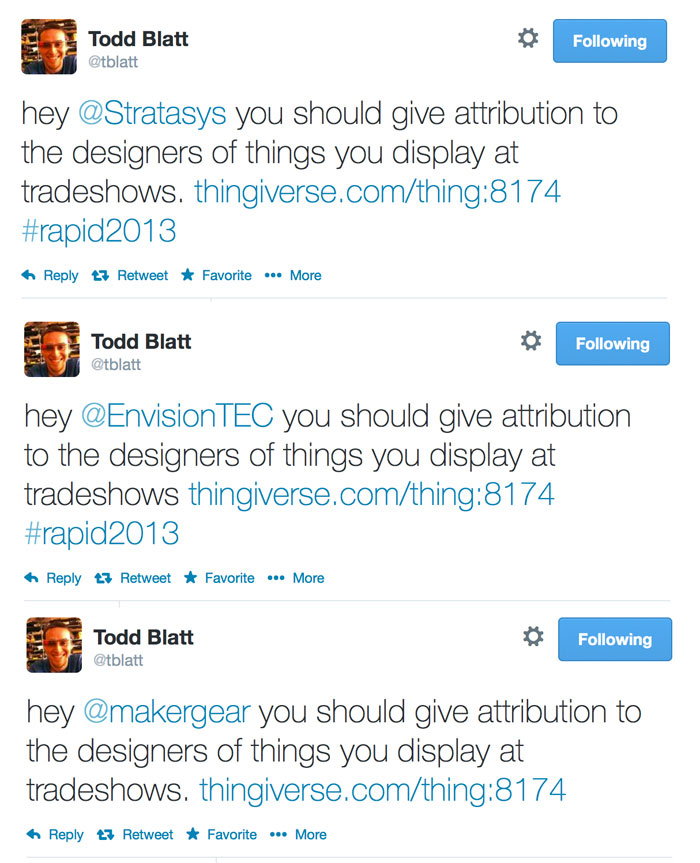The most discussed concerns surrounding IP and 3D printing come from manufacturers, mostly because they have the loudest voices in the room. The piracy of physical objects could stand to cost huge sums of money for big brands like IKEA, Disney, Lego, Hasbro and anyone else you can imagine. What you hear less about is infringement of IP from individual designers by 3D printer manufacturers.
The issue of using the work of 3D printing artists without consent was first raised on 3DPI in October, 2012 by Derek Quenneville. 3DP IP theft has reared its ugly head again recently. Indeed, last week when we covered the Titan 1 DLP 3D printer. Jessica Rosenkrantz, of Nervous System pointed out on twitter that the promo reel for the Titan 1 featured 3D printed pieces designed by her and her partner. (The video has since been made private.)
This isn’t the first time that Nervous System has had its work featured without consent or payment from a 3D printer manufacturer. In the case of small firms, like Kudo3D, these mistakes are a part of the learning curve faced by any new business. It’s certainly not the sort of behaviour you’d expect from an industry leader, like 3D Systems who also used Jessica’s work in the promo below, only adding a small attribution on a single image after Nervous System complained.
Asher Nahmias, the artist more formally known as Dizingof, had similar experiences, both with leading 3D printer manufacturers and the 3D printing community:
The issue began in mid 2012 when I started noticing individuals downloading my designs from Thingiverse – where they were offered for free, for personal use & non commercial use under the Creative Commons Attribution, non commercial License – and trying to monetize on them, be it on eBay or at street fairs.
One individual from Australia went as far as 3D printing a few of my Math Art designs, scaled them down for jewellery and then offered them on a Kickstarter campaign! I filed a complaint and that campaign was shut down immediately. The campaign owner claimed she didn’t know about the CC license.
Shortly after, the two big 3D printer manufacturers, 3D Systems & Stratasys ,were caught using my designs at shows to showcase their 3D printers’ capabilities.
The artist recounted the latter story to IT World. Both industry leaders had used his designs at trade shows and marketing events. After emailing Dan Yalon, executive vice president for business development and strategic marketing for Stratasys, about the unauthorized IP use, Yalon promised not to use his designs without permission in the future and even went so far as to promise to donate money to a charity of Nahmias’ choice. Unfortunately, to the best of the artist’s knowledge, no donation has been made:
3D Systems used Dizingof’s braided bracelet design for a promotional event at a Toys R Us in Hong Kong. The company’s CEO, Avi Reichental forwarded the blame to their Hong Kong partners, “It wasn’t our event. It was a third party event, and they downloaded the design, and used it in conjunction with us.” Nahmias, however, points to an email from the company’s Chief Strategy Officer, Ping Fu, who admitted, “I put a pink Dizigof’s braided torus in the center to show math art to children, upon his complaint, I promptly took down the model and credited him online in social media.”
Dizingof’s work was protected by a Creative Commons license, as the artist explained in a Google Groups discussion (later published in IT World): “Even if you bought any of my paid design files you are NOT allowed to use it for commercial displays to showcase your products as 3D Systems & Stratasys did without asking my permission nor placing attribution to designer – as per Creative Commons – Attribution – NON Commercial License.” By using the designs for promotional purposes, the 3D printer manufacturers stood to make a profit.
One recourse for 3DP designers is to issue a DMCA take down license to the copyright offender. Nahmias explains:
I left a message to Kudo3d.com – they are infringing the CC License of my design and if they don’t take it down or contact me for a PR license I will file a DMCA take down with their host as well as to kickstarter. This could hurt and I don’t want to do that.
I recently filed a DMCA takedown with a web host who immediately shutdown a website owned by a person from China who copied all my website content to his cloned site.
If other designers do the same, infringers will think twice next time knowing designers have the tools to immediately shut them down.
Later updating me:
[Update]: Kudo3d have removed my design & Nervous design from their website, YouTube and Kickstarter campaign.
They say they can not afford a PR license.
I wished them Good Luck.
Of course, DMCA takedown requests can only do so much. For small companies and individuals, the fear of a lengthy legal battle might work as a deterrent against future theft. Large companies may not be so afraid of lawyer fees.
Instead, artists like Todd Blatt might turn to twitter, in hopes of invoking the collective superego to reprimand and potentially boycott misbehaving companies:
In a world where public shaming of individuals on social media can potentially get companies to apologize for indiscretions or destroy the careers of TV chefs, those tweets might have the potential to change the industry. Despite any good that might come of the soap opera that plays out between the public and celebrities or big businesses, however, we can admit that, at times, shaming campaigns can feel a little unseemly (though it’s hard to find fault with pressuring destructive companies through social media).
But, as Michael Weinberg, an attorney and a vice president at Public Knowledge, implied in his comments to IT World, we may be early enough into the game for 3DP manufacturers to change their ways. Weinberg explains that the copyright infringement might not have been intentional, “What’s far more likely is the company didn’t take the time to think about what they were doing or the person who was doing it either didn’t understand what a Creative Commons license was or misinterpreted it… it’s a new world for them too. They’ve been in the business for over 20 years and probably most of those years the world of 3D printing designers was relatively small.”
While it may be easier to forgive small start-ups for the misuse of designs, it’s harder to overlook the misdeeds of large companies with their own design departments or the capital to hire outside designers. It may sound like I’m contradicting my own views about piracy here, as I’ve previously suggested that larger manufacturers give away their designs at a low cost, but I’m a fan of the underdog. It’s okay for the little person to do what he/she/zi can in a world run by powerful companies and, in my view, not okay for it to work the other way around. For that reason, I encourage readers to post their own stories of 3D-printed IP infringements in the comments below. Maybe that way, we can change this young industry before it’s too late.
Feature Image Source: Dizingof’s Braided Torus





